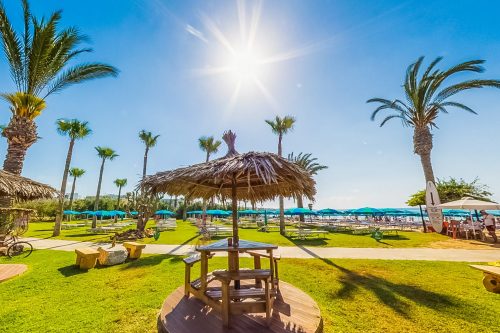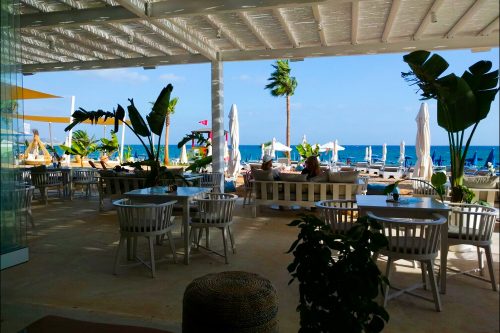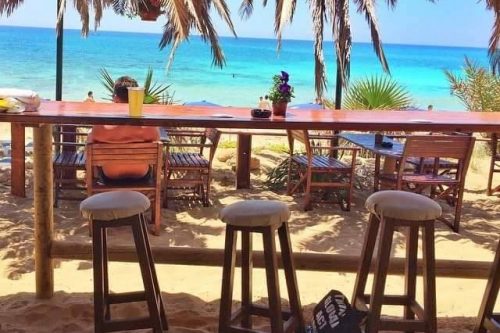About Us
The Napa Plaza Hotel is located in the lively center of Ayia Napa, adjacent to the medieval monastery by the Siakkas family. It has attracted thousands of tourists who appreciated the high standards, the friendly service and of course the convenient location in the heart of Ayia Napa. In 2004 the popular Napia Star departs, to leave its place to an elegant, modern new, the Napa Plaza. The ownership was committed to leverage the position of the hotel while meeting with the new requirements of our times and the hospitality industry. Everything was reconstructed and re-designed. The objective was the re-birth of an ultra-modern facility, for people looking for exceptionally high standards. The central idea of the architects was to give a hotel a distinct Mediterranean feel with a specific heritage, that is contemporary, chic and comfortable.
About Ayia Napa
Within a 7-minute walk from the Napa Plaza Hotel is the Ayia Napa Harbour, and just next to this Limanaki Beach. This is a sandy beach, sheltered from wind and waves with a lifeguard station.
Three beach bars/venues are located here, offering a full range of amenities such as free Wifi, loungers, and umbrellas (fee applies), changing rooms, showers and food & drink service.
Staying at the Napa Plaza allows you to stay in the heart of Ayia Napa while enjoying the beach just a short distance away.
The island of Cyprus that houses Ayia Napa is the third largest island in the Mediterranean Sea. The total size of the island is 9,251 kilometers with some of Europe’s most clean and clear beaches, as well as thriving olive and citrus groves. Thanks to the location of the island, Ayia Napa has wonderful weather, with very minimal amounts of winter temperatures.
Located around the area of Ayia Napa are several points of interest that only add to the beauty of the landscape. The Panagia Church is a vaulted church with twin aisles in dedication to the Virgin Mary. The church is also decorated in an unusual way with porcelain plates that date back to the 18th century. The church is located in Paralimni Village, which is 10 km north of Ayia Napa. In between Paralimni and Ayia Napa is Cavo Greco. The uniqueness of this National Forest Park is not only to its natural beauty but also the wide range of interests. Visitors can partake in diving, swimming, cycling, fishing, climbing, and hiking.
For exciting nightlife and entertainment, just off of the main promenade is a harbor with some delicious restaurants and bars. It is a great place to sit, relax, and watch the boats out in the water. The harbor also houses small fishing boats that are in action, and in the mornings you can purchase fresh fish for your dinner.
About 2 miles from the harbor is Nisi Beach. This is the most popular spot for visitors wanting to get sun and play in the water. This is also where all of the young tourists will flock during the day, before enjoying the clubbing scene by night. You can take a bus or walk to the beach. The route along the main road to the beach is lined with bars and shops, so there are shopping opportunities at every corner.
Back in town, make sure to visit the Municipal Town Hall, which is located in the heart of Ayia Napa. The building is newly built with modern features to help accommodate the growing amount of tourists. While learning about the town population might not be your interest, there are many things to see at the Town Hall. Each Thursday, during particular months of the year, there are a number of free concerts, performances, and recitals that you can see. The themes vary from Latin American dances to traditional folk. You can find the performances at the Cultural Centre.
Also at Town Hall, you can visit a number of museums. The Tornaritis is located on the lower level of Town Hall and has exhibits about past and present marine life. Founded in 1992, the main purpose is to show visitors the marine life of Cyprus and the Mediterranean, and the importance of preserving the environment. There is also a cinema which houses the latest films, and a modern fully equipped conference center.
Location Highlights
In historical district
In city center
In entertainment district
Nearby Points of Interest Ayia Napa Monastery – 0,1 km / 0,1 mi
Thalassa Museum – 0.3 km / 0.2 mi
Fishing & Boat Harbour – 0.5 km / 0.3 mi Grecian Bay Beach – 2 km / 1 mi
Nissi Beach – 3.5 km / 2 mi
About the Island of Cyprus
Cyprus – History, Climate & Hedonism
It has been said the very name Cyprus, shimmers with an ages-old mystique. Today, history and hedonism are comfortably intertwined on the island. One of the most impressive archaeological sites, the ancient city kingdom of Kourion, overlooks a magnificent stretch of beaches with a sparkling blue sea beyond. Along the island”s sun-kissed coastline, from Agia Napa in the east to Pafos in the west, world-class beach resorts alternate with settings untouched since antiquity. Explore Greek Orthodox churches located in the hills whose walls conceal vibrantly painted Byzantine frescoes. Many are found among the pine-covered peaks of the Troodos, where a sublime silence can dissolve all sense of time, not to mention stress. There are old wine-producing villages with atmospheric winding streets and terraced vineyards. You can often stay the night for a song in cozy renovated traditional houses, part of the Cyprus agrotourism programme.
All Eyes on Cyprus
Cyprus is the third largest island in the Mediterranean and an ideal starting point for the discovery of other exotic locales such as the Greek Islands, Egypt and the Middle East – in fact, mini-cruises set off for these places from Cyprus almost every day.
Travelers on business appreciate the fine conference facilities and warm, professional service at more than 64 hotels and resorts, and like incentive, groups value the proximity of the beach. And that golden Old World sunshine – there are generally 300-plus sunny days per year – is something few can resist. Add it all up and you have an ideally-situated island that truly has no equal. A place that measures up to its mystique: Cyprus.
Love Goddesses and Sacred Mountains
Throughout Cyprus, the typically Mediterranean landscape is still blessed with the timeless beauty of antiquity. There are crusader fortresses framed by tall cypress trees, Greco-Roman theatres carved out of cliffs and Byzantine monasteries perched improbably on mountaintops. The capital, Lefkosia (Nicosia), is surrounded by Venetian walls with heart-shaped bastions; Larnaka, site of the major international airport, is also home to St. Lazarus Church and the crypt of the eponymous saint resurrected by Christ. Near the animated harbor at Pafos is the Roman floor mosaics of the Houses of Aion, Achilles and Dionysus, their depictions of mythological scenes amazingly preserved.



